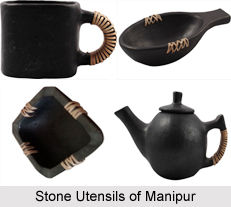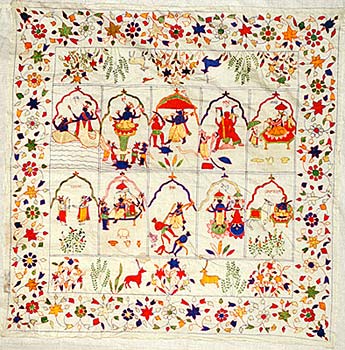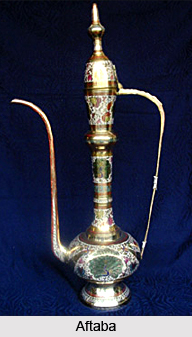 Besides the Puanchei, Puanndum and Tawlhloh Puan, there are multiple other different Puan designs of Mizo Kukis.
Besides the Puanchei, Puanndum and Tawlhloh Puan, there are multiple other different Puan designs of Mizo Kukis.
"Kawkpuizikzial" is perhaps the earliest textile design manufactured by the Mizos. It was produced in the likeness of one of the very common leafy vegetables. The leaves had their tips curled nicely in small round loops, which brought out the motif for the typical Mizo designs. Once design making came into vogue, fresh ones were devised in quick succession and the Puans started to take their names on the basis of the designs applied in them.
"Kawkpuipar" is the term used to refer to the Puan of semi-traditional type, being the modification of the old traditional Kawkpuizikzial. Their early fern leaves have been redesigned in circular shape to look like a flower. The flowers are arranged in neat rows and lines, running through the cloth breadth wise at regular intervals, covering the whole spread of the Puan. Each row of flowers has a different colour of its own, the final result being beautiful multicoloured Puan with matching colour combinations and arrangements. The prominent feature itself is the highlight of the clever permutation of colours, with the background being of any colour.
"Disul" is another earliest known Mizo Puan, characterised by the presence of a large number of coloured triangular designs facing one another in a manner such that their broad bases stand against each other, with a sort of a line intervening between them, more or less giving the appearance of a straight path. Such arrangement simultaneously leads to making the apices of each triangle touch one another. As a result, the whole appearance of the Puan takes the shape of well designed rectangles and triangles with continuous path like arrow stripes running through the diagonals of the rectangles as also against the end of the triangles. The earlier Puans used to adopt this design commonly. Even in modern Puans such as the Puanchei, it is an aspect of the design.
"Thangchhuah Puan" is the design that has a very high social significance, as it could be worn only by those who had earned the highly coveted distinction of performing Thangchhuah ceremony, a type of feast of merit. These Puans are usually bigger than the other Puans, and their surface background can be of any colour including white. Thin stripes are made to run length wise, covering the whole surface. In case the surface was woven with coloured yarn, the stripes used to be white while if the surface was white, the stripes could be of any colour. But what made this Puan unique was the fine embroidery work on the thin stripes, with innumerable designs. On each stripe, different designs were woven in small lengths varying from 15 to 20 centimetres. As a result, the Puan when completed assumed a very delicate look on the whole, with its completion usually taking long time.
"Thembupui-Chung" is a Puan with distinct design. When woven, the design appears only on its upper surface and no trace of embroidered work is visible on the other surface of the Puan. The term "Thembupui" in Mizo dialect refers to a bamboo rod used in their Loins loom, for separating the odd and even sets of warp threads. Perhaps thus, the Puan is so named after the method of weaving rather than its design.
"Par-zam" is a type of Puan that has mostly floral designs ("Par" meaning flower). The design consists of different types of floral motifs, with leaves, buds etc. In their proper setting, designs are woven out on the lower part of the Puan usually in the form of creepers. Varieties are created to effect through the use of different background colours and kinds of flowers. These designs are very common on shawls and stoles.
 "Naya Sawm Par" is another Puan decorated with floral motifs ("Par" = flower, "Sawm" = ten). The flowers are those of the 10 paise coin. This is a newly developed design, where the flowers are arranged in straight lines running across the Puan, with appropriate gaps here and there breaking the monotony. The Puan is elegant and popular.
"Naya Sawm Par" is another Puan decorated with floral motifs ("Par" = flower, "Sawm" = ten). The flowers are those of the 10 paise coin. This is a newly developed design, where the flowers are arranged in straight lines running across the Puan, with appropriate gaps here and there breaking the monotony. The Puan is elegant and popular.
"Arsi Par" is another elegant Puan. Since "Arsi" implies star and "Par" refers to flower, the name of the Puan has been derived from its design that resembles flower like stars. Small white flowers cover the entire lower half of the Puan, which appear somewhat like stars against the dark blue background. It is another recently adopted design.
"Kikiau" is derived from the Mizo term "Kikan" meaning zigzag, referring to zigzag designs that are woven on the Puan.
"Sawhthing Par" is a Puan with simple yet beautiful designs. It has been appropriately termed so as the design somehow resembles the flowers of the ginger plant ("Sawhthing" referring to ginger). There are two horizontal lines composed of a chain of diamond shaped units. And upon the lines, the ginger flowers are arranged all along. The designs are of different colours, which when appropriately chosen, make the fabric look beautiful.
"Fanghma Mu" is another simple and beautiful Puan and the term implies cucumber seeds. The component units which cover the whole Puan somehow appear like the seeds of cucumber. On a single colour background, the seed like designs are spread all through the cloth, leaving no gaps anywhere.
"Semit" is a simple Puan. The term in Mizo dialect implies the eye of mithun (a large semi-domesticated bovine, the genus of wild and domestic cattle). The beautiful single coloured Puan has four prominent embroidered lines running through it breadth wise at intervals. The diamond shaped designs, which have been correlated to mithun`s eyes, are placed compactly to form the lines.
"Siki Par" is another recent design of the Puan ornamented with circular ring like designs, which are of the size of "Siki", the 25 paise coins. The Siki flowers appear like a ring with a dot at the centre. Such flowers are woven all over the cloth, making lines both horizontally and vertically. Each vertical line is composed of one colour.
"Zawngdaikalh Chhunga Arsi Leh Phengphehlep Seh Thalak" refers to one of the most beautiful Puans, woven with much care with combinations of various motifs and designs. The name of the Puan is derived from the design characterised by lattice work, within which stars and butterflies are woven alternately. The pattern, on the whole, looks from a distance like diamonds placed compactly with butterflies and stars neatly arranged.
"Herhsawp Leh Kawkpui" is the Puan identified by the embroidered pattern of a number of English alphabets "X" in capital, placed together in line. The gaps between the "X" like designs are filled in with the Kawkpuipar designs. "Herhsawp" is a bamboo and cane foot stool (or Murah), shaped somewhat like the capital "X", hence the name of the Puan.
"Zawngdaikalh Leh Lace Par" is a Puan having lace designs embedded within lattice work. "X" like designs and diamond shaped designs are also seen prominently in the embroidered portions. "Zawngdaikalh Chhunga Lace Par" is another similar Puan having lace design within lattice work. In addition, there are few Puans such as Modern Senior Puan and Disul Modern Puan, which are actually modified versions of some of the Puans discussed above.
The textile design development of the Puans had actually taken place more in Mizoram than in Manipur, since the Mizos could get better support in Mizoram both from the society as well as administration, for various obvious reasons. But subsequently, it percolated first to Churachandrapur and then elsewhere, since the Mizos also marry in Manipur. Therefore, from the Mizos these designs subsequently percolated to other Kuki tribes who are their neighbours. Thus, the availability of the multifarious Puans within Manipur varies considerably from region to region. In some cases, it has been found that even other tribes as well tried to imitate these designs up to certain extent.
Related Articles:
Textiles of Manipur
Crafts of Manipur
Tribes of Manipur
Indian Costumes
Weaving and Dyeing Craft



















